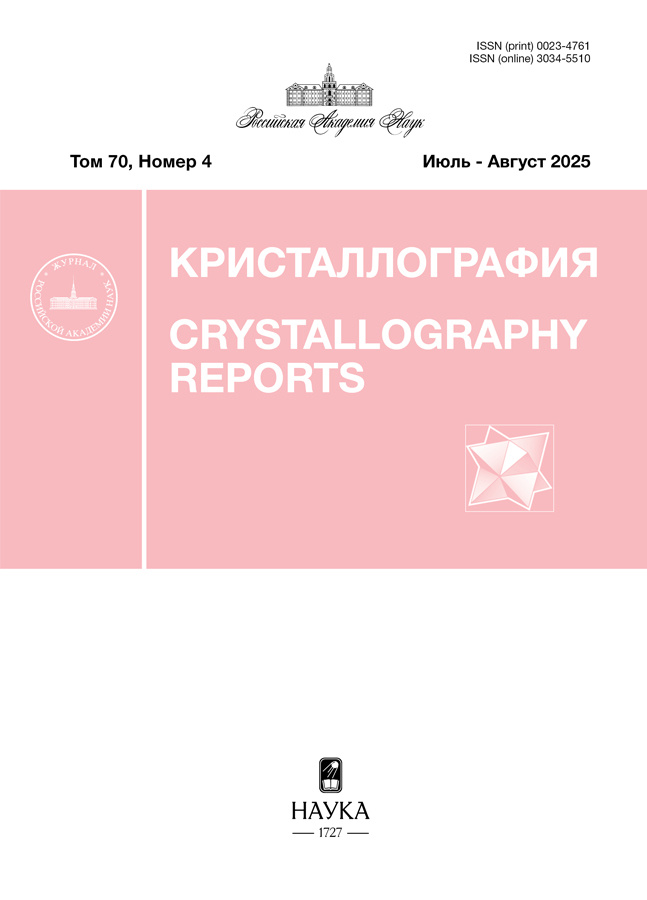Memory effects in magnetoplasticity of NaCl crystals
- Autores: Koldaeva M.V.1, Petrzhik E.A.1, Alshits V.I.1, Kvartalov V.B.1
-
Afiliações:
- National Research Center “Kurchatov Institute”
- Edição: Volume 70, Nº 4 (2025)
- Páginas: 613–625
- Seção: ФИЗИЧЕСКИЕ СВОЙСТВА КРИСТАЛЛОВ
- URL: https://bioethicsjournal.ru/0023-4761/article/view/688085
- DOI: https://doi.org/10.31857/S0023476125040109
- EDN: https://elibrary.ru/JGHSPV
- ID: 688085
Citar
Texto integral
Resumo
Memory effects in magnetoplasticity of NaCl crystals with different impurity content are studied. Dislocation paths and microhardness of crystals after their exposure to a constant magnetic field or to crossed ultralow magnetic fields are measured. In two crystals, noticeable relaxation displacements of dislocations, introduced after exposure, are found. In two other crystals with a lower impurity concentration, the paths remain at the background level, but in one of them, exposure causes an increase in the density of mobile dislocations. Similar magnetic exposure also leads to a decrease in the microhardness of crystals, but to different extent. Interpretation of observations is reduced to a spin-dependent transformation of impurity centers in a magnetic field, which plasticizes the crystal. Introduction of dislocations after magnetic exposure leads to their relaxation displacements from unstable positions, and at strongly weakened pinning centers, dislocations straight away take up positions close to equilibrium.
Texto integral
Sobre autores
M. Koldaeva
National Research Center “Kurchatov Institute”
Autor responsável pela correspondência
Email: mkoldaeva@ns.crys.ras.ru
Shubnikov Institute of Crystallography of the Kurchatov Complex Crystallography and Photonics
Rússia, MoscowE. Petrzhik
National Research Center “Kurchatov Institute”
Email: mkoldaeva@ns.crys.ras.ru
Shubnikov Institute of Crystallography of the Kurchatov Complex Crystallography and Photonics
Rússia, MoscowV. Alshits
National Research Center “Kurchatov Institute”
Email: mkoldaeva@ns.crys.ras.ru
Shubnikov Institute of Crystallography of the Kurchatov Complex Crystallography and Photonics
Rússia, MoscowV. Kvartalov
National Research Center “Kurchatov Institute”
Email: mkoldaeva@ns.crys.ras.ru
Shubnikov Institute of Crystallography of the Kurchatov Complex Crystallography and Photonics
Rússia, MoscowBibliografia
- Альшиц В.И., Даринская Е.В., Перекалина Т.М., Урусовская А.А. // ФТТ. 1987. Т. 29. С. 467.
- Альшиц В.И., Даринская Е.В., Колдаева М.В., Петржик Е.А. // Кристаллография. 2003. Т. 48. С. 826.
- Урусовская А.А., Альшиц В.И., Смирнов А.Е., Беккауер Н.Н. // Кристаллография. 2003. Т. 48. С. 855.
- Моргунов Р.Б. // Успехи физ. наук. 2004. Т. 174. С. 131. https://doi.org/10.3367/UFNr.0174.200402c.0131
- Головин Ю.И. // ФТТ. 2004. Т. 46. С. 769.
- Alshits V.I., Darinskaya E.V., Koldaeva M.V., Petrzhik E.A. // Magnetoplastic effect in nonmagnetic crystals. In: Dislocations in Solids. V. 14. Ch. 86. / Ed. Hirth J.P., Amsterdam: Elsevier, 2008. P. 333–437. https://doi.org/10.1016/S1572-4859(07)00006-X
- Осипьян Ю.А., Моргунов Р.Б., Баскаков А.А. и др. // Письма в ЖЭТФ. 2004. Т. 79. С. 158.
- Badylevich M.V., Kveder V.V., Orlov V.I., Osipyan Yu.A. // Phys. Status Solidi. C. 2005. V. 2. P. 1869. https://doi.org/10.1002/pssc.200460534
- Тяпунина Н.А., Красников В.Л., Белозёрова Э.П., Виноградов В.Н. // ФТТ. 2003. Т. 45. С. 95.
- Zhang X., Zhao Q., Wang Z. et al. // J. Phys.: Condens. Matter. 2021. V. 33. P. 435702. https://doi.org/10.1088/1361-648X/ac1823
- Guo Y., Lee Y.J., Zhang Y. et al. // J. Mater. Sci. Technol. 2022. V. 112. P. 96. https://doi.org/10.1016/j.jmst.2021.09.049
- Cai Z., Qlan C., Zhang X. et al. // Friction. 2024. V. 12. P. 2139. https://doi.org/10.1007/s40544-023-0833-0
- Guo Y., Zhan J., Lu W.F., Wang H. // Int. J. Mech. Sci. 2023. V. 263. P. 108768. https://doi.org/10.1016/j.ijmecsci.2023.108768
- Song Y., Wu W., Yu Y., Hua L. // Chin. J. Mech. Eng. 2023. V. 36. P. 139. https://doi.org/10.1186/s10033-023-00961-y
- Пост Р., Осинская Ю.В., Вильде Г. и др. // Поверхность. Рентген., синхротр. и нейтрон. исслед. 2020. № 5. С. 36. https://doi.org/10.31857/S102809602005012X
- Зельдович Я.Б., Бучаченко А.Л., Франкевич Е.Л. // Успехи физ. наук. 1988. Т. 155. С. 3. https://doi.org/10.3367/UFNr.0155.198805a.0003
- Steiner U.E., Ulrich T. // Chem. Rev. 1989. V. 89. P. 51. https://doi.org/10.1021/cr00091a003
- Бучаченко А.Л. // ЖЭТФ. 2006. Т. 129. С. 909.
- Бучаченко А.Л. // ЖЭТФ. 2007. Т. 132. С. 827.
- Бучаченко А.Л. // Успехи физ. наук. 2019. Т. 189. С. 47. https://doi.org/10.3367/UFNr.2018.03.038301
- Дистлер Г.И., Каневский В.М., Москвин В.В. и др. // Докл. АН СССР. 1983. Т. 268. С. 591.
- Головин Ю.И., Моргунов Р.Б. // Письма в ЖЭТФ. 1993. Т. 58. С. 189.
- Darinskaya E.V., Petrzhik E.A., Ivanov Yu.M. et al. // Phys. Status Solidi. C. 2005. V. 2. P. 1873. https://doi.org/10.1002/pssc.200460553
- Петржик Е.А., Даринская Е.В., Демьянец Л.Н. // ФТТ. 2008. Т. 50. С. 614.
- Колдаева М.В., Турская Т.Н., Закалюкин Р.М., Даринская Е.В. // Кристаллография. 2009. Т. 54. С. 1009.
- Даринская Е.В., Колдаева М.В., Альшиц В.И. и др. // Письма в ЖЭТФ. 2018. T. 108. С. 236. https://doi.org/10.1134/S0370274X18160038
- Моргунов Р.Б., Бучаченко А.Л. // ЖЭТФ. 2009. Т. 136. С. 505.
- Петржик Е.А., Альшиц В.И. // Письма в ЖЭТФ. 2021. T. 113. С. 678. https://doi.org/10.31857/S1234567821100074
- Альшиц В.И., Даринская Е.В., Колдаева М.В., Петржик Е.А. // ЖЭТФ. 2016. Т. 149. С. 136. https://doi.org/10.7868/S0044451016010120
- Альшиц В.И., Колдаева М.В., Петржик Е.А., Даринская Е.В. // ЖЭТФ. 2024. Т. 166. С. 696. https://doi.org/10.31857/S0044451024110129
- Альшиц В.И., Даринская Е.В., Колдаева М.В., Петржик Е.А. // Письма в ЖЭТФ. 2016. Т. 104. С. 362. https://doi.org/10.7868/S0370274X16170124
- Koldaeva M.V., Alshits V.I. // AIP Adv. 2024. V. 14. P. 015015. https://doi.org/10.1063/5.0177619
- Петржик Е.А., Альшиц В.И. // ЖЭТФ. 2025. T. 167. Вып. 6. С. 823. https://doi.org/10.31857/S0044451025060082
- Головин Ю.И., Моргунов Р.Б. // ЖЭТФ. 1999. Т. 115. С. 605.
- Бацанов С.С. Структурная химия (факты и зависимости). Гл. 4. М.: Диалог-МГУ, 2000. 292 с.
- Бучаченко А.Л. // ЖЭТФ. 2007. Т. 132. С. 673.
- Альшиц В.И., Даринская Е.В., Казакова О.Л. // ФТТ. 1998. Т. 40. С. 81.
Arquivos suplementares
















